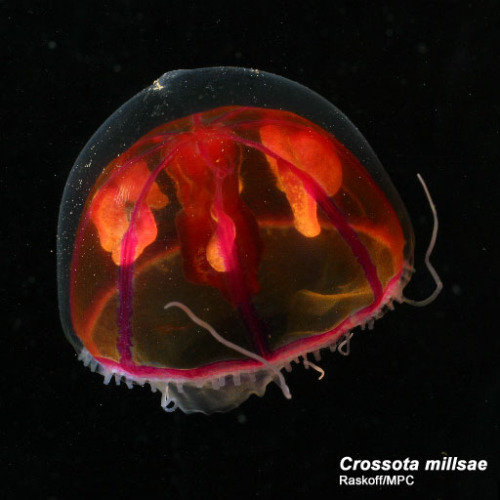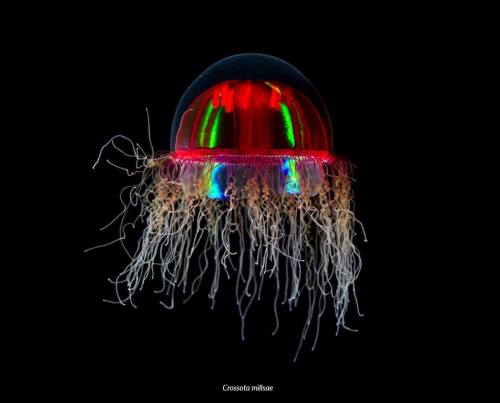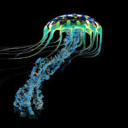Black Medusa

Black Medusa
Vampyrocrossota childressi
The Black Medusa is an inky, black hydrozoan that absorbs all light that hits its tiny body. It has a translucent gelatin and a black umbrella; it is also only 1.5 cm in size. Moreover, it is found at depths between 600m to 1500m, and it spends its entire life floating in the deep ocean.
Photo credit: https://www.pinterest.com/pin/488148047080475827/
More Posts from Bioluminescentoceangoddess and Others


Cigar Comb Jelly
beroe forskalii
The Cigar Comb Jelly is a gelatinous ctenophore that is marveled by many due to its sparkling bioluminescence. It tends to elegantly float around 120 m in the ocean. It uses unique, hair-like structures called ctens to move horizontally in the ocean. It also swims in a spiral pattern before consuming zooplankton in the ocean.
Photo credit: https://www.wrobelphoto.com/gelatinouszooplankton/h25347306
https://www.flickr.com/photos/a_migotto/27227530815

Black- eyed squid
Gonatus onyx
The Black-eyed Squid is roughly over one foot (35 am) and is found at depths as deep as 2500m. The female Black-eyed Squid works fiercely to protect her babies, by carrying around a patch of egg for six to nine months. When the eggs hatch, 2000 to 3000 babies are released into the ocean. However, this makes her vulnerable to predators.
Photocredit: http://tolweb.org/Gonatus+onyx/19769


Deep Sea Arrow Worm
Eukrohnia hamata
Arrow worms are small, predatory marine worms that consume copepods, ostracods, and larvae. They resembles a clear, ink pen whizzing through the dark sea. Furthermore, they are found primarily in the Artic Ocean between 700m to 1200m. The picture on the bottom is its head. They have 8 hooks, which are used to grab prey and 25 posterior teeth. Even though the arrow worms are terrifying up close, they are only 4.5 cm in size.
Photo credit: http://www.arcodiv.org/watercolumn/chaetognaths/Eukrohnia_hamata.html

Scaly Dragonfish
Stomias Boa
The Scaly Dragonfish is about 32cm long and found at depths between 200 to 1500m. The long purple barbel on its chin is used to lure in prey. When the pery gets close enough, it swings its jaws forward swallowing the prey whole.
Photo credit: https://alchetron.com/Stomias
Video on the fish: https://www.youtube.com/watch?time_continue=69&v=9oB_61aI2iQ&feature=emb_title


Psychedelic Medusa
Crossota millsae
The Psychedelic Medusa is a deep-sea hydrozoan that is abundant in the North Pacific. The mini-jelly is found at depths between 1000m to 3800m, and are often observed drifting near the ocean floor. It also has an eccentric reproduction behavior uncommon in cnidarians. The females display viviparity, and carry the babies in her bell until they are ready to hatch.
Photo credit: http://www.arcodiv.org/watercolumn/cnidarian/Crossota_millsae.html
https://twitter.com/spothvegr/status/1030177493075079169


Giant Bell Jelly
Scrippsia pacifica
The Giant Belly Jelly has 256 tentacles attached to a gelatinous bell-shaped base. Like most cnidarians, the Giant Belly Jelly uses specialized stinging cells called nematocysts to catch its prey. When fish and other prey swim into its tentacles, the sensory projection on the cnidocyte (cell that holds the nematocysts) is activated. Then the nematocysts and barb are released, hitting the vulnerable prey and releasing a toxin into the prey’s body. The Giant Bell Jelly is found at 400 m in the ocean. It is related to the jellyfish, but it is categorized as a Hydrozoa (similar to the Portuguese- man-o-war)
https://vimeo.com/42551565
Photo Credit: https://www.pinterest.cl/pin/467107792572034837/
https://courses.lumenlearning.com/ivytech-bio1-1/chapter/phylum-cnidaria/


Helmet Jelly
Periphylla periphylla
The Helmet Jelly can be found at all depths of the ocean. This vibrant and strange jellyfish tends to proliferate in Norwegian fjords. They are one of the dominant predators in these isolated ecosystems.
Photos
http://www.seawater.no/fauna/cnidaria/periphylla.html
https://www.bigfishexpeditions.com/2019/01/24/norway-deepwater-shark-diving-2018/helmet-jelly/





Wake up babe new fish dropped

Glass Octopus
Vitreledonella richardi
The Glass Octopus spend its entire life in the midwater section of the ocean and found at depths between 200m to 2000m. Even though it has no protection from predators, it achieves perfect transparency. The only part of the Glass Octopus that is visible is its digestive gland. However, the digestive gland is placed vertically to minimize detection. In addition, I find this octopus to be super cute!
Photo credit: https://www.mynumer.com/forums/topic/499/invisible-animals/view/post_id/859


Pigbutt worm
Chaetopterus pugaporcinus
The Pigbutt worm or the flying buttocks of the sea is spotted floating between 965 m to 1300 m in the deep ocean. It is actually a polychaete (polly-keet) worm species that burrows in the ground as an adult, and floats around the ocean as a baby. The worm feeds itself : by creating a balloon of mucus; collecting particles on the mucus; and then consuming the particles. It is the rarest and thickest worm in the deep ocean, for only ten have been spotted.
Photocredit: https://roaring.earth/pigbutt-worm/
-
 mawsteeth liked this · 2 years ago
mawsteeth liked this · 2 years ago -
 thickadaswamppossumwitdamumps reblogged this · 2 years ago
thickadaswamppossumwitdamumps reblogged this · 2 years ago -
 dragonwitch77 liked this · 2 years ago
dragonwitch77 liked this · 2 years ago -
 lauraatulsa reblogged this · 3 years ago
lauraatulsa reblogged this · 3 years ago -
 lauraatulsa liked this · 3 years ago
lauraatulsa liked this · 3 years ago -
 silver-lily-louise liked this · 3 years ago
silver-lily-louise liked this · 3 years ago -
 eathotchip-and-bi liked this · 3 years ago
eathotchip-and-bi liked this · 3 years ago -
 repenomamus reblogged this · 3 years ago
repenomamus reblogged this · 3 years ago -
 anathematic liked this · 3 years ago
anathematic liked this · 3 years ago -
 aeshnacyanea2000 reblogged this · 3 years ago
aeshnacyanea2000 reblogged this · 3 years ago -
 marmartheimp liked this · 3 years ago
marmartheimp liked this · 3 years ago -
 fated-to-madness liked this · 3 years ago
fated-to-madness liked this · 3 years ago -
 sleppybitch liked this · 3 years ago
sleppybitch liked this · 3 years ago -
 broodriber reblogged this · 3 years ago
broodriber reblogged this · 3 years ago -
 astrotracksuitbattalion liked this · 3 years ago
astrotracksuitbattalion liked this · 3 years ago -
 acolorcollective liked this · 3 years ago
acolorcollective liked this · 3 years ago -
 despair-with-walnuts liked this · 3 years ago
despair-with-walnuts liked this · 3 years ago -
 repenomamus liked this · 3 years ago
repenomamus liked this · 3 years ago -
 sundry-whovengerslocked liked this · 3 years ago
sundry-whovengerslocked liked this · 3 years ago -
 windyboysworld liked this · 3 years ago
windyboysworld liked this · 3 years ago -
 balsamic--vinegar liked this · 3 years ago
balsamic--vinegar liked this · 3 years ago -
 miresgaleth liked this · 3 years ago
miresgaleth liked this · 3 years ago -
 mindwalkrhyme reblogged this · 3 years ago
mindwalkrhyme reblogged this · 3 years ago -
 oniongarlic reblogged this · 3 years ago
oniongarlic reblogged this · 3 years ago -
 hepatitisneedle liked this · 3 years ago
hepatitisneedle liked this · 3 years ago -
 agent-plaguemask reblogged this · 3 years ago
agent-plaguemask reblogged this · 3 years ago -
 strangevoidkingdom liked this · 3 years ago
strangevoidkingdom liked this · 3 years ago -
 roharen reblogged this · 3 years ago
roharen reblogged this · 3 years ago -
 creaturedeityendless liked this · 3 years ago
creaturedeityendless liked this · 3 years ago -
 vaguelyexistingcloud liked this · 3 years ago
vaguelyexistingcloud liked this · 3 years ago -
 spacebobareborn liked this · 3 years ago
spacebobareborn liked this · 3 years ago -
 malicemidnight liked this · 3 years ago
malicemidnight liked this · 3 years ago -
 brobablykenn reblogged this · 3 years ago
brobablykenn reblogged this · 3 years ago -
 low-level--00 liked this · 3 years ago
low-level--00 liked this · 3 years ago -
 thecosmicsnap liked this · 3 years ago
thecosmicsnap liked this · 3 years ago -
 someonebetter liked this · 3 years ago
someonebetter liked this · 3 years ago -
 ash-the-nekogirl reblogged this · 3 years ago
ash-the-nekogirl reblogged this · 3 years ago -
 ash-the-nekogirl liked this · 3 years ago
ash-the-nekogirl liked this · 3 years ago -
 phenomenonologyofperception reblogged this · 3 years ago
phenomenonologyofperception reblogged this · 3 years ago -
 salvagethevixin liked this · 3 years ago
salvagethevixin liked this · 3 years ago -
 the-stranger-in-town reblogged this · 3 years ago
the-stranger-in-town reblogged this · 3 years ago -
 the-stranger-in-town liked this · 3 years ago
the-stranger-in-town liked this · 3 years ago -
 princesspeach124 liked this · 3 years ago
princesspeach124 liked this · 3 years ago

Bioluminescence is a chemical reaction that produces light. Many deep sea animals use bioluminescence. This blog is dedicated to educating the public about the amazing creatures that thrive in the deep sea.
57 posts